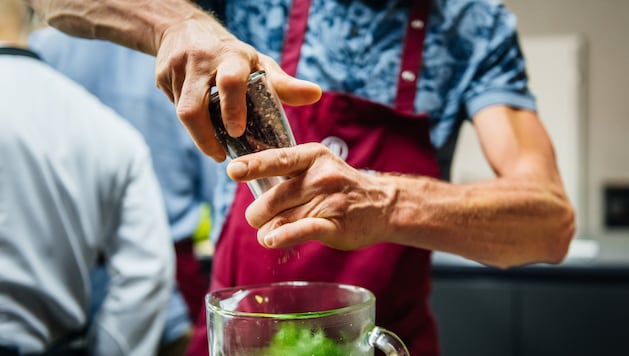You can do something good for your intestinal flora with an everyday spice. Pepper not only gives dishes a pleasantly spicy flavor, but it is also really healthy. Here you can read how pepper supports your health.
We know pepper primarily as a spicy spice from the kitchen that gives meals a pleasant spiciness.
But the fact that pepper can also be used specifically as a medicine has now been almost forgotten. The green, white, red or black spice is a natural medicine that most people have on their kitchen shelves anyway.
The alkaloid piperine contained in pepper promotes blood circulation throughout the body; As a result, more saliva is produced in the mouth and more gastric juice in the stomach. On the one hand, it stimulates the appetite, and on the other hand, heavy food is digested better and faster due to the increased amount of gastric juice.
You can easily prepare pepper tea to combat constipation:
However, if you have diarrhea, inflammation of the gastric mucosa or a stomach ulcer, it is advisable to avoid pepper.
Piperine also triggers a pain signal in the body. This releases the body’s own endorphins, which improve your mood. Piperine also curbs the breakdown of the happiness hormone serotonin: you feel better for longer with pepper than without it. The breakdown of dopamine is also inhibited, which means you can concentrate better for longer.
It is worthwhile to season meals with tasty pepper for very different reasons. If you don’t like it so spicy, it’s best to use green pepper, which is comparatively mild, while spicy eaters are better off with black pepper because the spiciness, piperine, is present in the highest concentration.
Cold symptoms such as an increased feeling of cold (“shivering”) are also alleviated by pepper: thanks to the circulation-promoting effect of piperine, pepper literally makes you feel warm.
If you have a fever, the body sweats more quickly after taking pepper, which cools down the body and allows the fever to go down more quickly.
Compared to chili or cayenne pepper, pepper is still moderately hot and is therefore also suitable for people who do not like or tolerate excessive heat. Pepper also stimulates the mucous membranes of the lower and upper respiratory tract to produce increased mucus, thereby helping to get rid of bacteria more quickly by coughing or blowing your nose.
You can take advantage of all these effects with a simple cold drink with pepper. This is how the drink is prepared:
You can drink the pepper drink two to three times a day. How much pepper is added depends on how much spiciness you like and can tolerate. It is advisable to start with a small pinch and find out what amount of pepper suits your personal taste.
Tip: A pepper wrap also helps against typical cold symptoms and promotes healing.
The circulation-promoting effect of pepper can also be used in a pepper massage oil, which helps to relieve tension and sore muscles.
This is how the pepper massage oil is made:
If stored in a cool place, the oil will last for one to two years.
To use, spread a little oil on your hands and massage into tense areas of the body. Areas of skin with neurodermatitis or psoriasis are better avoided.
Tip: To increase the effect of the oil even further, you can add a few dried chili flakes to the oil mixture. Optionally, 20 drops each of rosemary or juniper essential oil enhance the effect and ensure a pleasant scent. If this oil isn’t strong enough for you or if you don’t have time to massage, you can also make a warming chili ointment yourself and apply it to your skin.
Peppercorns are the fruits of the pepper bush (Piper nigrum), a climbing plant that was originally only native to southern India, but is now also grown in Indonesia, Malaysia, Vietnam and Brazil. The most important component of pepper is piperine, which not only benefits our health but also preserves meat and fish. It was precisely the preservative effect that made pepper a widely traded commodity in ancient times and into the Middle Ages, whose weight was sometimes worth in gold due to the long transport routes.
Whether black, red, white or green peppercorns: they all come from the same pepper bush and were just harvested and processed at different times:
The mild pink pepper usually found in pepper mixtures is not pepper, but comes from Brazilian or Peruvian Chinus trees, which belong to the sumac family and are therefore related to cashews and mangoes.
Most pepper is grown conventionally and without organic production methods, which is why residues of pesticides or even mineral oils can be found in many pepper products, which spoil the healthy enjoyment of the hot grains. In addition, the best quality peppercorns are usually not used for ground pepper.
It is therefore advisable to use organic products and whole grains when it comes to pepper. In terms of taste, unground peppers are vastly superior to ground pepper because the volatile essential oils that contribute to the taste are only released at the time of preparation.
The original for this article “Surprising spice is really good for digestion” comes from smarticular.









